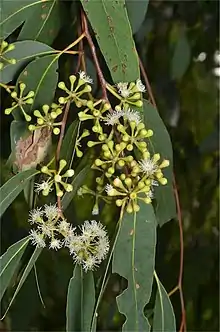Eucalyptus racemosa
Eucalyptus racemosa, commonly known as snappy gum or narrow-leaved scribbly gum,[2] is a species of small to medium-sized tree that is endemic to eastern Australia. It has smooth, mottled bark, lance-shaped to curved or egg-shaped adult leaves, flower buds in groups of between seven and fifteen, white flowers and cup-shaped, conical or hemispherical fruit.
| Snappy gum | |
|---|---|
 | |
| Eucalyptus racemosa near the Nowra-Braidwood road | |
| Scientific classification | |
| Kingdom: | Plantae |
| Clade: | Tracheophytes |
| Clade: | Angiosperms |
| Clade: | Eudicots |
| Clade: | Rosids |
| Order: | Myrtales |
| Family: | Myrtaceae |
| Genus: | Eucalyptus |
| Species: | E. racemosa |
| Binomial name | |
| Eucalyptus racemosa | |
| Synonyms[1] | |
|
Synonyms
| |

Description
Eucalyptus racemosa is a tree that typically grows to a height of 15–20 m (49–66 ft), rarely a mallee, and forms a lignotuber. It has smooth, mottled white, yellow, grey or cream-coloured bark with insect scribbles. Young plants and coppice regrowth have dull green, egg-shaped leaves that are 50–170 mm (2.0–6.7 in) long, 25–85 mm (0.98–3.35 in) wide and petiolate. Adult leaves are the same shade of glossy green on both sides, lance-shaped to curved or egg-shaped, 65–200 mm (2.6–7.9 in) long and 10–35 mm (0.39–1.38 in) wide on a petiole 10–25 mm (0.39–0.98 in) long. The flower buds are usually arranged in leaf axils in groups of between seven and fifteen on an unbranched peduncle 5–25 mm (0.20–0.98 in) long, the individual buds on pedicels 3–6 mm (0.12–0.24 in) long. Mature buds are oval, 3–5 mm (0.12–0.20 in) long and 2–3 mm (0.079–0.118 in) wide with a rounded or conical operculum. Flowering mainly occurs from July to September and the flowers are white. The fruit is a woody, cup-shaped, conical or hemispherical capsule 3–6 mm (0.12–0.24 in) long and 4–7 mm (0.16–0.28 in) wide with the valves near rim level.[2][3][4]
Taxonomy
Eucalyptus racemosa was first formally described in 1797 by the botanist Antonio José Cavanilles in his book Icones et Descriptiones Plantarum.[5][6] The specific epithet (racemosa) is a Latin word meaning "having racemes", which is a misnomer, as it does not have flowers in racemes.[7]
Distribution and habitat
Snappy gum grows in woodland and forest, sometimes in pure stands, on poor sandstone soils in mid to high rainfall areas. It is found along the coast, tablelands and western slopes from Bombala, Bathurst and Albury in New South Wales to Gympie and Bundaberg in south-eastern Queensland.[2][3][8]
Ecology
The distinctive scribbles often found on the bark of this eucalypt are caused by the scribbly gum moth, Ogmograptis racmosa.[9]
Gallery
- Features of the scribbly gum (Eucalyptus racemosa)
 Adult leaves and buds
Adult leaves and buds Fruit
Fruit Trunk bark
Trunk bark Bark, buds and leaves
Bark, buds and leaves
References
- "Eucalyptus racemosa". Australian Plant Census. Retrieved 9 December 2019.
- Hill, Ken. "Eucalyptus racemosa". Royal Botanic Garden Sydney. Retrieved 9 December 2019.
- "Eucalyptus racemosa subsp. racemosa". Euclid: Centre for Australian National Biodiversity Research. Retrieved 29 May 2020.
- Chippendale, George M. "Eucalyptus racemosa". Australian Biological Resources Study, Department of the Environment and Energy, Canberra. Retrieved 9 December 2019.
- "Eucalyptus racemosa". APNI. Retrieved 9 December 2019.
- Cavanilles, Antonia José (1797). Icones et Descriptiones Plantarum (Volume 4). Madrid: Eius operas dirigente Petro Iuliano Pereyra. p. 24. Retrieved 9 December 2019.
- "Eucalyptus racemosa – Narrow-leaved Scribbly Gum / Snappy Gum" (PDF). Hornsby Shire Council. Retrieved 31 December 2017.
- Brooker & Kleinig (1990). A Field Guide to Eucalypts. 1. p. 126. ISBN 0-909605-62-9.
- Horak, M.; Day, M.; Edwards, T.; Barlow, C.; Su, Y. N.; Cameron, S. "Scriibly gum moths". csiropedia.csiro.au. CSIRO. Retrieved 30 December 2017.